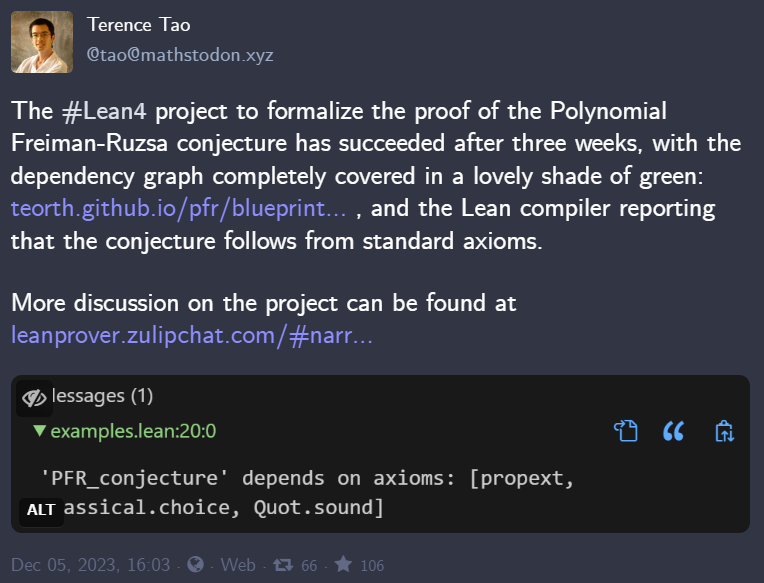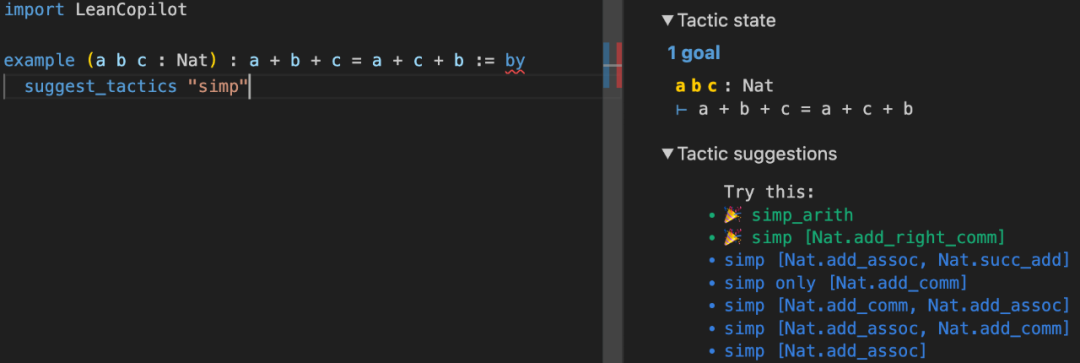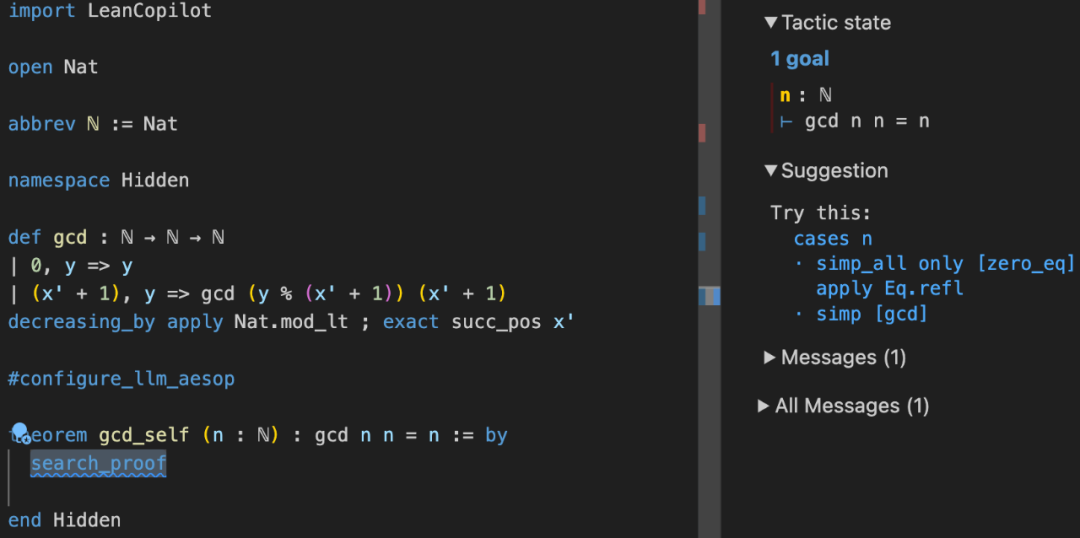 Technology peripherals
Technology peripherals
 AI
AI
 Terence Tao uses large-scale model proof assistant Lean to show his preference
Terence Tao uses large-scale model proof assistant Lean to show his preference
Terence Tao uses large-scale model proof assistant Lean to show his preference
"I predict that, if used correctly, AI will become a trusted co-author in mathematical research and many other fields by 2026." Mathematician Terence Tao said in a previous blog.
Tao Zhexuan said this and did it.
He has recently been conducting mathematical research using tools such as GPT-4, Copilot, and Lean, and also discovered a hidden bug in his paper with the help of AI.

Recently, Terence Tao stated that the Lean4 project has successfully completed the formalization of the proof of the Polynomial Freiman-Ruzsa Conjecture (PFR), which took only three days. week. At the same time, the Lean compiler also reports that the conjecture conforms to the standard axioms. This is a great success proved by computers and AI, and it is exciting

For more information about the above research, interested readers can Refer to "What is Tao Zhexuan's formal proof using AI?" Understand the past and present life of PFR conjecture in one article.
Seeing this, careful readers may have discovered the clue. Master Tao mentioned Lean many times when conducting mathematical research. Simply put, Lean is a programming language that helps mathematicians verify theorems, where users can write and verify proofs. Compared with the original Lean, the latest Lean 4 version has many optimizations, including a faster compiler, improved error handling, and better integration with external tools.
Lean is widely used in the field of mathematics. Today, when large models (LLM) are popular, is there a better way to combine the two?
Now someone has realized it, the open platform LeanDojo team (for LeanDojo, please refer to "AI large model helps Tao Zhexuan solve problems, and can also prove mathematics Theorem? ") and researchers from the California Institute of Technology launched Lean Copilot, a collaboration tool designed for LLM and human interaction, aiming to provide 100% accurate formal mathematical proof.

It is worth noting that the LeanDojo team’s research mainly focuses on using LLM to automate theorem proving. From this point, it is not difficult to see that they launched It's not surprising that Lean Copilot is related to LLM.

Project address: https://github.com/lean-dojo/LeanCopilot
For This research, apart from saying it is cool, is very cool, and the evaluation is still very high.

Use LLM in Lean to speed up mathematical proof
For a long time, automated theorem proving has been faced with Due to many difficulties, mathematical proofs traditionally rely on manual derivation and require careful verification. Now with the advancement of AI, researchers have begun to use artificial intelligence to conduct in-depth exploration, but this problem is inevitable, that is, LLM is sometimes not very reliable in mathematics and reasoning tasks, and is prone to errors and hallucinations.
The function of Lean Copilot allows users to use large language models to automate the proof process in Lean and improve the speed of proof synthesis. When needed, users can also seamlessly intervene and modify to achieve balanced collaboration between machine intelligence and human intelligence
Using Lean Copilot, LLM can be used in Lean to achieve proof automation , including strategy suggestions, premises and search proofs
Users can choose to use the built-in models provided by LeanDojo, or import their own models. These models can be run locally (with or without a GPU), or in the cloud
#In short, Lean Copilot provides users with a flexible way to enhance it by introducing LLM and optimize the process of theorem proving in Lean.
The main features of Lean Copilot can be summarized as:
- LLM is able to propose proof steps, search for proofs, and select useful lemmas from a large mathematical library.
- Lean Copilot can be set up as a Lean package and runs seamlessly within a Lean VS Code workflow.
- Users can use the built-in models in LeanDojo, or use their own models, which can be run locally (with or without GPU) or in the cloud.
- The tool runs on a variety of platforms, including Linux, macOS, and Windows WSL.
To make LLM more accessible to Lean users, Lean Copilot hopes to start a positive feedback loop: proving that automation will lead to better data and ultimately improve LLM’s performance in mathematics performance.
Copilot’s effect demonstration
You can configure Lean Copilot according to the official tutorial. After the configuration is completed, you can start the experiment. The author of the project also provides some official examples for reference
Recommended solutions. After importing LeanCopilot, you can use suggest_tactics to generate recommended solutions. During use, you can also click on the recommended solution and use it in the proof (refer to the image below)

You can use a prefix, For example, simp, to limit the generated strategy

search proof. Use search_proof to combine LLM-generated policies with aesop (Lean 4’s white-box automation project) to search for multiple policy proofs. Once you find the proof, you can click on the strategy to insert it into the editor

Rewritten content: Choosing the premise is an important one Strategy. The purpose of this strategy is to retrieve a list of potentially useful premises. Currently, Lean Copilot will use the search tool in LeanDojo to select premises from the fixed snapshot of Lean and mathlib4 (i.e., Lean 4 math library)

You can run LLM. Whether it's theorem proving or other reasoning, you can run LLM in Lean. You can run any model locally or remotely (see Bring Your Own Model)

Some advanced usages are also mentioned in the project for interested readers , you can go to the original project to learn more.
The above is the detailed content of Terence Tao uses large-scale model proof assistant Lean to show his preference. For more information, please follow other related articles on the PHP Chinese website!

Hot AI Tools

Undresser.AI Undress
AI-powered app for creating realistic nude photos

AI Clothes Remover
Online AI tool for removing clothes from photos.

Undress AI Tool
Undress images for free

Clothoff.io
AI clothes remover

Video Face Swap
Swap faces in any video effortlessly with our completely free AI face swap tool!

Hot Article

Hot Tools

Notepad++7.3.1
Easy-to-use and free code editor

SublimeText3 Chinese version
Chinese version, very easy to use

Zend Studio 13.0.1
Powerful PHP integrated development environment

Dreamweaver CS6
Visual web development tools

SublimeText3 Mac version
God-level code editing software (SublimeText3)

Hot Topics
 1662
1662
 14
14
 1419
1419
 52
52
 1312
1312
 25
25
 1262
1262
 29
29
 1235
1235
 24
24
 Open source! Beyond ZoeDepth! DepthFM: Fast and accurate monocular depth estimation!
Apr 03, 2024 pm 12:04 PM
Open source! Beyond ZoeDepth! DepthFM: Fast and accurate monocular depth estimation!
Apr 03, 2024 pm 12:04 PM
0.What does this article do? We propose DepthFM: a versatile and fast state-of-the-art generative monocular depth estimation model. In addition to traditional depth estimation tasks, DepthFM also demonstrates state-of-the-art capabilities in downstream tasks such as depth inpainting. DepthFM is efficient and can synthesize depth maps within a few inference steps. Let’s read about this work together ~ 1. Paper information title: DepthFM: FastMonocularDepthEstimationwithFlowMatching Author: MingGui, JohannesS.Fischer, UlrichPrestel, PingchuanMa, Dmytr
 The world's most powerful open source MoE model is here, with Chinese capabilities comparable to GPT-4, and the price is only nearly one percent of GPT-4-Turbo
May 07, 2024 pm 04:13 PM
The world's most powerful open source MoE model is here, with Chinese capabilities comparable to GPT-4, and the price is only nearly one percent of GPT-4-Turbo
May 07, 2024 pm 04:13 PM
Imagine an artificial intelligence model that not only has the ability to surpass traditional computing, but also achieves more efficient performance at a lower cost. This is not science fiction, DeepSeek-V2[1], the world’s most powerful open source MoE model is here. DeepSeek-V2 is a powerful mixture of experts (MoE) language model with the characteristics of economical training and efficient inference. It consists of 236B parameters, 21B of which are used to activate each marker. Compared with DeepSeek67B, DeepSeek-V2 has stronger performance, while saving 42.5% of training costs, reducing KV cache by 93.3%, and increasing the maximum generation throughput to 5.76 times. DeepSeek is a company exploring general artificial intelligence
 AI subverts mathematical research! Fields Medal winner and Chinese-American mathematician led 11 top-ranked papers | Liked by Terence Tao
Apr 09, 2024 am 11:52 AM
AI subverts mathematical research! Fields Medal winner and Chinese-American mathematician led 11 top-ranked papers | Liked by Terence Tao
Apr 09, 2024 am 11:52 AM
AI is indeed changing mathematics. Recently, Tao Zhexuan, who has been paying close attention to this issue, forwarded the latest issue of "Bulletin of the American Mathematical Society" (Bulletin of the American Mathematical Society). Focusing on the topic "Will machines change mathematics?", many mathematicians expressed their opinions. The whole process was full of sparks, hardcore and exciting. The author has a strong lineup, including Fields Medal winner Akshay Venkatesh, Chinese mathematician Zheng Lejun, NYU computer scientist Ernest Davis and many other well-known scholars in the industry. The world of AI has changed dramatically. You know, many of these articles were submitted a year ago.
 Hello, electric Atlas! Boston Dynamics robot comes back to life, 180-degree weird moves scare Musk
Apr 18, 2024 pm 07:58 PM
Hello, electric Atlas! Boston Dynamics robot comes back to life, 180-degree weird moves scare Musk
Apr 18, 2024 pm 07:58 PM
Boston Dynamics Atlas officially enters the era of electric robots! Yesterday, the hydraulic Atlas just "tearfully" withdrew from the stage of history. Today, Boston Dynamics announced that the electric Atlas is on the job. It seems that in the field of commercial humanoid robots, Boston Dynamics is determined to compete with Tesla. After the new video was released, it had already been viewed by more than one million people in just ten hours. The old people leave and new roles appear. This is a historical necessity. There is no doubt that this year is the explosive year of humanoid robots. Netizens commented: The advancement of robots has made this year's opening ceremony look like a human, and the degree of freedom is far greater than that of humans. But is this really not a horror movie? At the beginning of the video, Atlas is lying calmly on the ground, seemingly on his back. What follows is jaw-dropping
 KAN, which replaces MLP, has been extended to convolution by open source projects
Jun 01, 2024 pm 10:03 PM
KAN, which replaces MLP, has been extended to convolution by open source projects
Jun 01, 2024 pm 10:03 PM
Earlier this month, researchers from MIT and other institutions proposed a very promising alternative to MLP - KAN. KAN outperforms MLP in terms of accuracy and interpretability. And it can outperform MLP running with a larger number of parameters with a very small number of parameters. For example, the authors stated that they used KAN to reproduce DeepMind's results with a smaller network and a higher degree of automation. Specifically, DeepMind's MLP has about 300,000 parameters, while KAN only has about 200 parameters. KAN has a strong mathematical foundation like MLP. MLP is based on the universal approximation theorem, while KAN is based on the Kolmogorov-Arnold representation theorem. As shown in the figure below, KAN has
 Tesla robots work in factories, Musk: The degree of freedom of hands will reach 22 this year!
May 06, 2024 pm 04:13 PM
Tesla robots work in factories, Musk: The degree of freedom of hands will reach 22 this year!
May 06, 2024 pm 04:13 PM
The latest video of Tesla's robot Optimus is released, and it can already work in the factory. At normal speed, it sorts batteries (Tesla's 4680 batteries) like this: The official also released what it looks like at 20x speed - on a small "workstation", picking and picking and picking: This time it is released One of the highlights of the video is that Optimus completes this work in the factory, completely autonomously, without human intervention throughout the process. And from the perspective of Optimus, it can also pick up and place the crooked battery, focusing on automatic error correction: Regarding Optimus's hand, NVIDIA scientist Jim Fan gave a high evaluation: Optimus's hand is the world's five-fingered robot. One of the most dexterous. Its hands are not only tactile
 Kuaishou version of Sora 'Ke Ling' is open for testing: generates over 120s video, understands physics better, and can accurately model complex movements
Jun 11, 2024 am 09:51 AM
Kuaishou version of Sora 'Ke Ling' is open for testing: generates over 120s video, understands physics better, and can accurately model complex movements
Jun 11, 2024 am 09:51 AM
What? Is Zootopia brought into reality by domestic AI? Exposed together with the video is a new large-scale domestic video generation model called "Keling". Sora uses a similar technical route and combines a number of self-developed technological innovations to produce videos that not only have large and reasonable movements, but also simulate the characteristics of the physical world and have strong conceptual combination capabilities and imagination. According to the data, Keling supports the generation of ultra-long videos of up to 2 minutes at 30fps, with resolutions up to 1080p, and supports multiple aspect ratios. Another important point is that Keling is not a demo or video result demonstration released by the laboratory, but a product-level application launched by Kuaishou, a leading player in the short video field. Moreover, the main focus is to be pragmatic, not to write blank checks, and to go online as soon as it is released. The large model of Ke Ling is already available in Kuaiying.
 The latest from Oxford University! Mickey: 2D image matching in 3D SOTA! (CVPR\'24)
Apr 23, 2024 pm 01:20 PM
The latest from Oxford University! Mickey: 2D image matching in 3D SOTA! (CVPR\'24)
Apr 23, 2024 pm 01:20 PM
Project link written in front: https://nianticlabs.github.io/mickey/ Given two pictures, the camera pose between them can be estimated by establishing the correspondence between the pictures. Typically, these correspondences are 2D to 2D, and our estimated poses are scale-indeterminate. Some applications, such as instant augmented reality anytime, anywhere, require pose estimation of scale metrics, so they rely on external depth estimators to recover scale. This paper proposes MicKey, a keypoint matching process capable of predicting metric correspondences in 3D camera space. By learning 3D coordinate matching across images, we are able to infer metric relative



